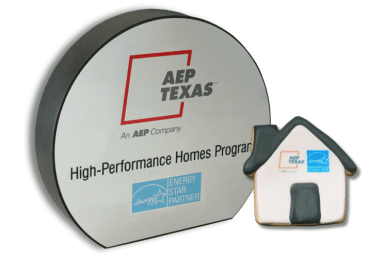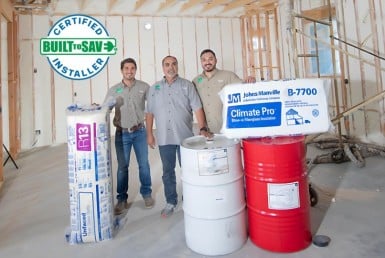Tired of Hearing About Energy Efficient, High-Performance Homes?—Well, maybe you need to READ this!
For years, homebuyers have been told about the advantages of building an energy efficient home to save money, and about “green building” to save the earth’s natural resources. Yet while a growing number of people (and builders) have taken the leap and made energy efficiency and renewable energy a priority in their home buying/home building endeavors, a vast majority have not.
We use the word “leap” because at some point, one has to have faith in the advantages of a high-performance home and believe in its benefits, without actually experiencing what sounds like marketing fluff. If we compare the homebuyer benefits of a home certified in the BUILT TO SAVE™ high-performance program, for example, it would seem like a no-brainer to make this certification a priority and not just settle for minimum standards. Therefore, the big questions are: a) why doesn’t every builder build energy efficient, high-performance homes? and b) why doesn’t every homebuyer demand one?
The answers are quite simple. First, let’s look at the builder’s perspective. Building high-performance homes are not required by law. The State of Texas only requires cities to adopt and enforce its minimum building code laws. The key word here is “minimum,” especially when it comes to energy efficiency. The good news is that the State of Texas raised the bar on those minimum requirements with the adoption of the 2015 International Energy Conservation Code (IECC) and mandated that every new home sold after August 1, 2016, comply with its new requirements. One major component of the new law requires homes to receive a Blower Door test and Duct Leakage test after completion to make sure that the minimum standards have been met (see page 6 for description of tests). The bad news is that not all municipalities enforce the new law. Some are still on 2012 or 2009 versions of the building code. Most unfortunate is that many builders think that their new homes are in compliance with state law simply because their home passed their city’s inspections. What the builders fail to recognize is that it is their responsibility to follow the 2015 IECC requirements—not the code officials’.
Next, the number one reason given by builders as to why they don’t certify their homes as high performance is that “people don’t ask for it.” Sadly, that’s a good reason—especially if builders’ eyes are more on their bottom line than on energy efficiency and compliance. Yet blaming it on the buyer is not a good answer. Instead, those builders that actually do go above and beyond the minimum standards required by law without buyers requesting it should be recognized for their genuine effort to build the best high-performance home they can for their homebuyers and not just one to meet bare minimum legal standards. BUILT TO SAVE™ builders, for example, invest more time for less profit to build a better home for their customer even if their customer is not asking for it. Even more applaudable should be the fact that BUILT TO SAVE™ builders are not afraid to have their work inspected and tested by an independent third-party inspector for verification of work that complies with Texas laws. NOT building a high-performance home may seem to make sense financially—for the builder—but not so much for the homebuyer’s ultimate long-term investment.
As for the homebuyers, the reasons their buying decisions are not driven by the energy efficiency of a home are more varied. No matter how much money they will save on a high-performance home over the years, basically, it comes down to what’s more important to them.
Energy efficiency and money savings on utilities cannot be shown off, touched, or enjoyed every day while exotic granite countertops, designer light fixtures, and elegant flooring can. Often, people buy a home that’s built to minimum code standards—and not high performance—because that’s all they know. There’s one important factor in the decision-making process that plays a major role and that’s this: “People often only know what they are told.” And you have not and will never hear a builder say he or she does not build an energy efficient home. They all say they do. But to what extent? That’s the main reason the BUILT TO SAVE™ program’s mantra is “Ask for proof.”
While we all may agree that saving money on utilities (and the earth’s resources) when building a home is important, too often there are many other things that give us more satisfaction. Much like trying to convince a child that eating vegetables is a lot better for their health in the long run than eating greasy fries and ice cream, for example, it isn’t easy to convince homebuyers of the long-term benefits of a high-performance home and how well it will serve them in the future when they are only focused on more exciting things in the home.
One final thought to keep in mind about BUILT TO SAVE™’s high-performance homes, and one that is super important, is that it isn’t all just about the money saved on utilities or repairs. As part of the certification process, BUILT TO SAVE™ homes provide benefits that cannot be seen but can be felt every day in the home—more comfort and better indoor air quality are only two. Take comfort, for example. In the BUILT TO SAVE™ program, a pre-construction review of the building plans by a third-party ensures that the heating and air-conditioning system is properly sized for the size of the home. Undersized units will run longer, consume more electricity, and need replacement sooner. Oversized units—a more common problem—cycle on and off more often because they cool the space faster and also consume more energy and require more maintenance. More importantly, the oversized units never stay on long enough to remove all the moisture in the air, so a home will always feel muggy and uncomfortable—something, unfortunately, you’ll feel every day.
Accordingly, while we’ve established that most people agree that conserving our natural resources is the right thing to do, they aren’t lined up to build green or energy efficient homes with better performance than required by minimum code standards. The best advice for homebuyers is to get informed about the BUILT TO SAVE™ program and its true benefits. Like eating a healthy diet of vegetables for a healthier lifestyle throughout your life, later on you’ll be glad you put “high performance” on the “Must Have” items of your home shopping list.
For more benefits of a BUILT TO SAVE™ high-performance home, visit www.BuiltToSave.org where you will also see a list of local builders who are building BUILT TO SAVE™ homes.





